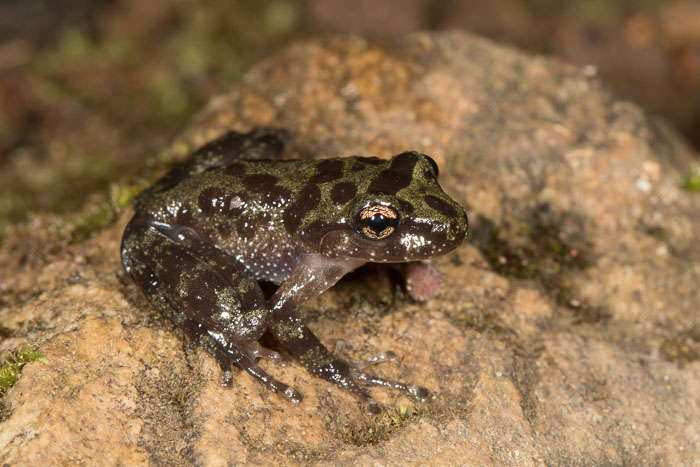Cover photo by A. Coetzer.
Find the Eastern Ghost Frog in the FBIS database (Freshwater Biodiversity Information System) here.
Family Heleophrynidae
Identification
Adult:
Size: Males attain 35mm; Females up to 46mm long.

Grootvadersbosch Nature Reserve, Western Cape
Photo by Trevor Hardaker
The body of Heleophryne orientalis is flattened, enabling them to shelter under rocks and in narrow crevices. They possess large, bulging eyes that feature a broad horizontal line and a smaller vertical line (The pupil is vertical). This gives the eye a crossed appearance. The tympanum (ear drum) is not visible.
The colouration and patterning is somewhat variable. The base colour ranges from beige to olive green with darker brown blotches, spots and bands. A band between the eyes is usually present. The undersides are white.
Adults develop asperities (small, rough protrusions) on the skin at several places, including the fingers, arms and chest.
They have fairly long arms and legs. The fingers and toes are also elongate and have spatulate tips and large discs to enhance grip on slippery surfaces. The feet are well webbed allowing Heleophryne orientalis to be strong swimmers.
Males are smaller than females. Breeding males develop swollen forearms, loose skin on the back and spines on the chest and inner fingers.
Tadpole:
Size: Up to 60mm.
Tadpoles of Heleophryne orientalis are broad, flattened and very streamlined. They are equipped with powerful tails and large sucker mouths. These are adaptations to prevent them from being swept away in fast-flowing torrents. The oversized sucker-like mouths also enable them to leave the water and climb vertical rock surfaces.
The overall colouration is yellow-brown with variable mottling. The tail is slightly longer than the body and the upper and lower fins are of roughly equal length.
Habitat
The Eastern Ghost Frog is confined to patches of Afromontane Forest surrounded by moist Mountain Fynbos (Moll et al. 1984). The average rainfall at these sites ranges from 600 – 3000mm per annum (Boycott 1982). Here Heleophryne orientalis inhabits perennial mountain streams in forested ravines and gorges. They prefer streams with cold, clear water that is often tea-coloured due to tannins from decaying vegetation. These streams often slow to a trickle in the dry season but can become swift-flowing torrents on the wet season.
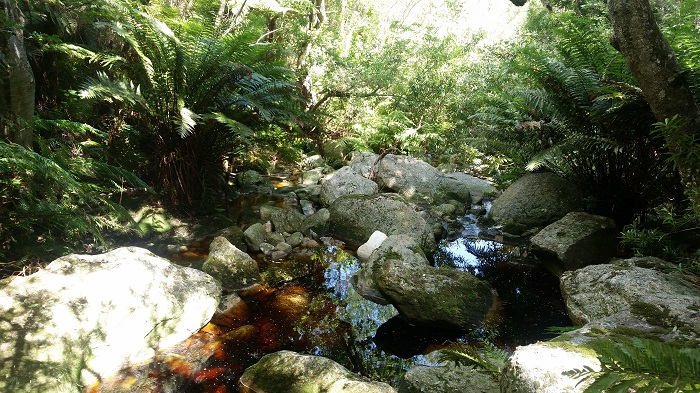
Photo by Ryan Tippett
The Eastern Ghost Frog is often found near waterfalls and cascades, on wet rock faces, in rock cracks and in caves. The tadpoles may be found beneath submerged and partly submerged rocks in swift- and slow-flowing streams and in rocky pools.

Photo by Ryan Tippett
Behaviour
Heleophryne orientalis breeds in early summer when river and stream flow is reduced. This is from mid-October to mid-December with the peak during November.
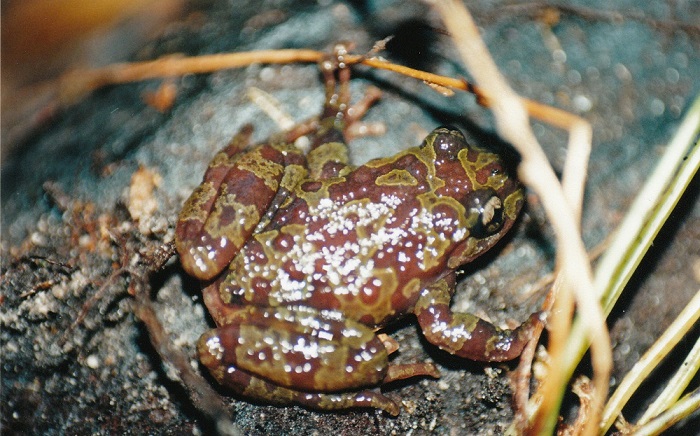
Grootvadersbosch Nature Reserve, Western Cape
Photo by Felicity Grundlingh
Calling takes place during the day and night. Males call from various sites inside or adjoining the water, such as from under rocks and from caves and crevices. They may additionally advertise themselves from exposed positions such as lichen-covered boulders near waterfalls and cascades.
Unlike most of the other Heleophryne species, the males of H. orientalis appear to form breeding aggregations, at least during peak periods. Several individuals may be found calling within close proximity to one another.
Egg laying in H. orientalis happens largely outside of the water, yet always in moist environments. Often the only available moisture is a thin layer of water seeping over the substrate on which the eggs are laid. This differs from the egg-laying habits of the other Heleophryne species which lay their eggs while completely submerged in water. Between 114–191 eggs, are laid in clutches in damp moss-covered places between boulders, or under small rocks in the streambed.
Tadpoles feed on algae growing on submerged surfaces in streams and pools. They find shelter under loose pebbles and boulders when disturbed. Their colouration closely matches that of the water and the substrate on which they feed.
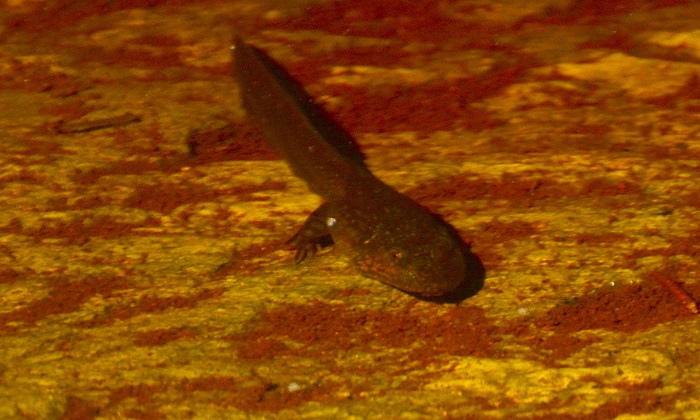
Marloth Nature Reserve, Western Cape
Photo by Ryan Tippett
Status and Conservation
Heleophryne orientalis is not threatened. It is listed as of Least Concern in the IUCN Red List of Threatened Species.
H. orientalis occurs abundantly in forested ravines and gorges on the southern slopes of the eastern Langeberg Mountains and is under no threat. The species occurs in several private and public protected areas such as the Grootvadersbosch and Marloth Nature Reserves.
Distribution
Heleophryne orientalis is endemic to the Western Cape Province of South Africa. It occurs along the eastern Langeberg Mountains, from near Montagu in the west to the Gouritz River in the east. The Eastern Ghost Frog has been recorded at altitudes ranging from 215-500 m/asl.
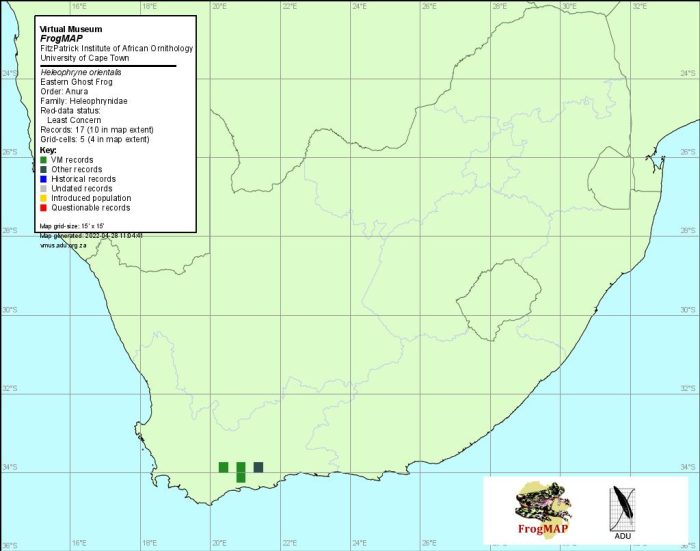
The atlas records are reliable but incomplete. Heleophryne records allocated to H. orientalis (as presently defined) were based on the range of H. purcelli orientalis as recognized by Poynton (1964) and Boycott (1982). What remains to be determined are the eastern limits of the range of H. purcelli and the western limits of the range of H. orientalis. It is unlikely that the distributions of the two species overlap.
Further Resources
The use of photographs by A. Coetzer, Felicity Grundlingh, and Trevor Hardaker is acknowledged. Other images by Ryan Tippett.
Eastern Ghost Frog Heleophryne orientalis (FitzSimons, 1946)
Other Common Names: Oostelike Spookpadda (Afrikaans).
Recommended citation format: Boycott, RC; Tippett, RM. (2025). Eastern Ghost Frog Heleophryne orientalis. Biodiversity and Development Institute, Cape Town. Available online at https://thebdi.org/2021/08/05/eastern-ghost-frog-heleophryne-orientalis/
This species text has been updated and expanded from the text in the
2004 frog atlas: Boycott, RC. (2004). Eastern Ghost Frog Heleophryne orientalis. In Minter LR
et al 2004.
References:
Minter, LR; Burger, M; Harrison, JA; Braack, HH; Bishop, PJ; Kloepfer, D. (Editors). (2004). Atlas and Red Data Book of the Frogs of South Africa, Lesotho and Swaziland. Smithsonian Institution, Washington, and Avian Demography
Unit, Cape Town.
Carruthers, V; du Preez, L. (2017). Frogs of southern Africa: A Complete Guide. Struik Nature, Cape Town.
Channing, A. (2001) Amphibians of Central and Southern Africa. Protea Book House, Pretoria
Claus, B; Claus, R. (2002). Common Amphibians and Reptiles of Botswana. Gamsberg Macmillan, Windhoek.

